Key Points:
COVID
- In today’s Recommendation for Industry, we discuss the overall positive trajectory of COVID cases, even with variants continuing to emerge. Read more below.
- WHO: COVID-19 cases, deaths drop globally. The World Health Organization (WHO) said global COVID-19 cases were down 11% in the week ending on Sep 25, and deaths were down 18% compared to the previous week. Omicron is still the main variant of concern, representing 99.9% of cases reported globally in the past week. The global COVID totals are 616,275,830 cases and 6,540,285 deaths. Japan’s Shionogi & Co has proved a successful trial with its antiviral protease inhibitor known as ensitrelvir. The drug performed well compared with a placebo in phase 3 trials and was able to reduce symptoms from Omicron-caused infections.
- Report: COVID-19 has lowered lifespan across the Americas. A report from the Pan American Health Organization (PAHO) shows that COVID-19 reduced life expectancy across the Americas while amplifying economic inequities and existing health disparities. Health expectancy across the region fell to levels not seen since 2004. Life expectancy in Latin America and the Caribbean decreased from 75.1 years in 2019 to 72.2 in 2021, a decline of 2.9 years. In North America, expected lifespan dropped from 79.5 years in 2019 to 77.7 in 2021, or by 1.8 years. In addition to declining life expectancy, both routine childhood immunization levels and mental health diagnoses have suffered under the veil of COVID-19. In other COVID-19 news, child COVID-19 cases declined for the fourth consecutive week in the United States, with 55,000 reported for the week ending Sep 22, according to the latest update from the American Academy of Pediatrics.
Monkeypox
- Unvaccinated individuals 14 times more likely to get monkeypox than vaccinated, new US data shows. That figure reflects the first wave of authoritative data collected by the Biden administration on the efficacy of the monkeypox vaccine that is currently being administered across the United States. There is still ongoing research being performed on the Jynneos vaccine.
Food Safety & Public Health
- Activities for the Safety of Imported Produce. There are four goals this activity document outlines, from the 2019 import strategy, in which the agency will be working to enhance the safety of fresh fruits and vegetables:
- Food Offered for Import Meets U.S. Food Safety Requirements
- FDA Border Surveillance Prevents Entry of Unsafe Foods
- Rapid and Effective Responses to Unsafe Imported Food
- Effective and Efficient Food Import Program
- Food safety tips for those in Hurricane Ian’s path. Within this source, authors point out numerous tips for individuals who find themselves affected during and after the hurricane and what correct food safety steps they should take. Read more here.
- FDA Proposes to Update Definition for “Healthy” Claim on Food Labels. The “healthy” claim can act as a quick signal on food package labels to help empower consumers, including those with lower nutrition knowledge, with information to identify foods that will help them build healthy eating patterns. The proposed changes to the definition of “healthy” are aligned with current nutrition science, the Dietary Guidelines for Americans, 2020-2025 and the updated Nutrition Facts label. The FDA’s approach focuses on ensuring that nutrient-dense foods that help consumers build a diet consistent with current dietary recommendations can qualify to bear the claim. The FDA is also researching a symbol that manufacturers could use on the front of the pack to show that their product meets the definition of the “healthy” claim.
Recommendations for Industry
U.S. on Positive Trajectory, though COVID Variant Emergence Continues
An overall positive COVID outlook in the U.S. is being somewhat supplanted in certain areas by the continuing rise of new variants.
Overall, TAG’s COVID matrix is continuing to show a significant decrease in case rates across much of the U.S. However, cases and transmission rates have risen somewhat in the Northeast, particularly in New Jersey and New York. A review of CDC’s 9/18-9/24 NOWCAST map (below) indicates that this increase may be related to the emergence of BA.4.6 and BA.2.75 (with BA.4.6 reflected in the dark blue portions of the pie charts).
As CDC explains, SARS-CoV-2, the virus that causes COVID-19, is constantly changing and accumulating mutations in its genetic code, so new variants are expected to continue to emerge. Some will emerge and disappear, while others will emerge and continue to spread and may replace previous variants.
Related to other communicable diseases that TAG has been tracking:
- Monkeypox cases are continuing to trend downwards. While there are still upwards of 500+ cases in 10 states (California, Washington, Texas, Illinois, New York, Pennsylvania, Delaware, North Carolina, Florida, and Georgia), newly discovered cases are diminishing.
- Influenza case have begun trending upward, with case rates seen as very high in Washington DC, and moderately high in Georgia, Texas, New Mexico, and Hawaii.
TAG will continue watching and assessing the emergence of COVID variants, as well as the seasonal re-emergence of the flu to keep you informed and advised on best practices for protection.
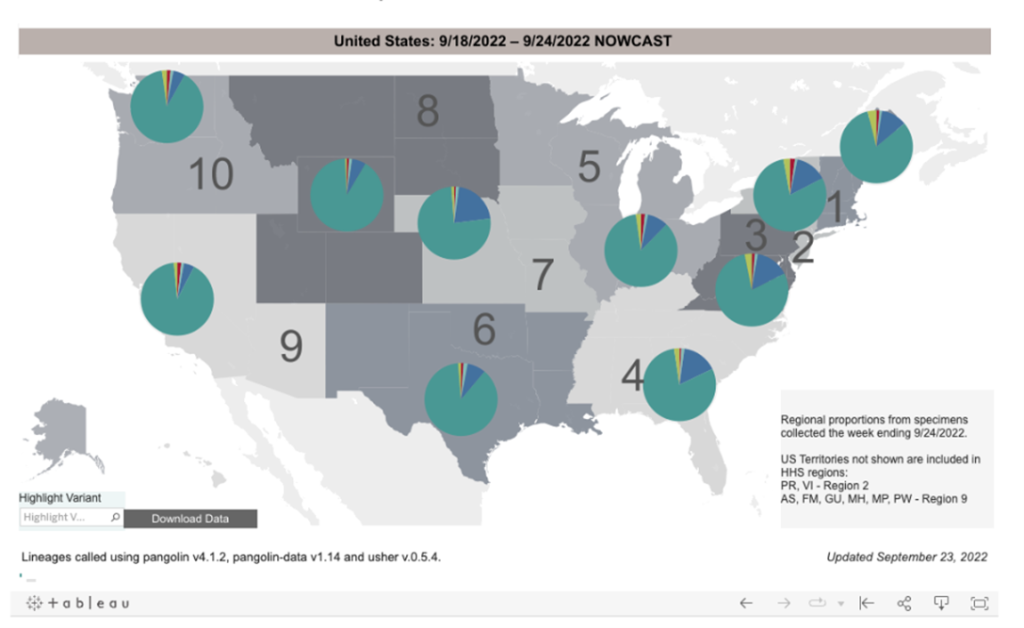
Risk Matrix:
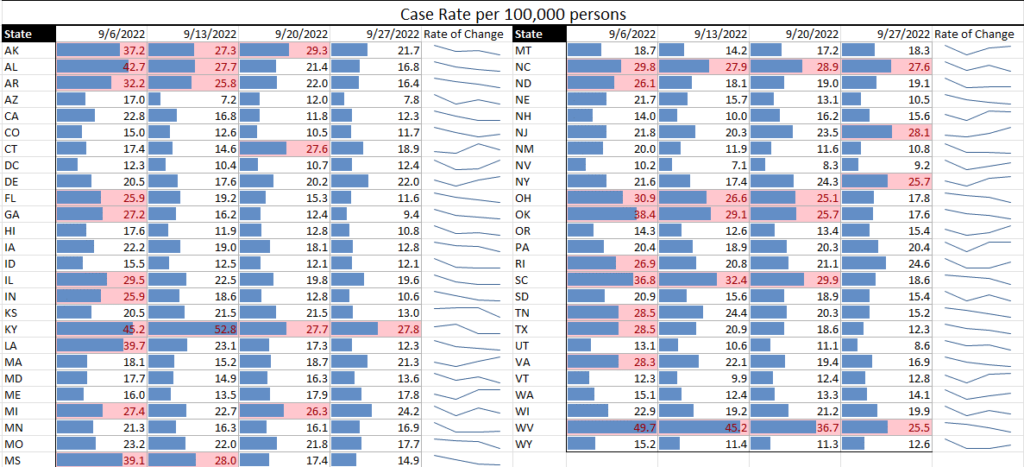
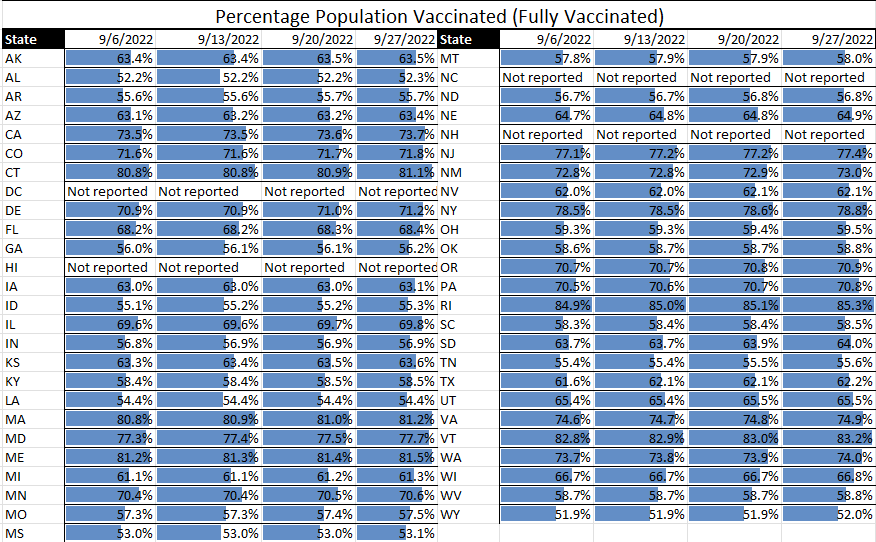

Monkeypox:
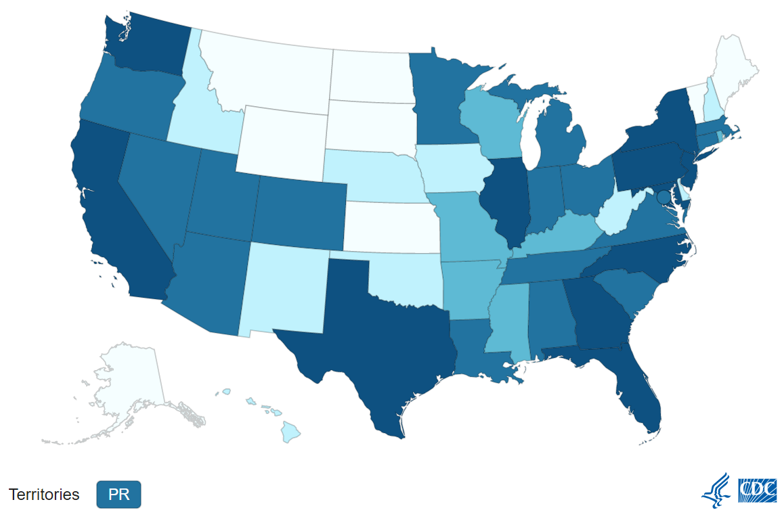


Influenza:

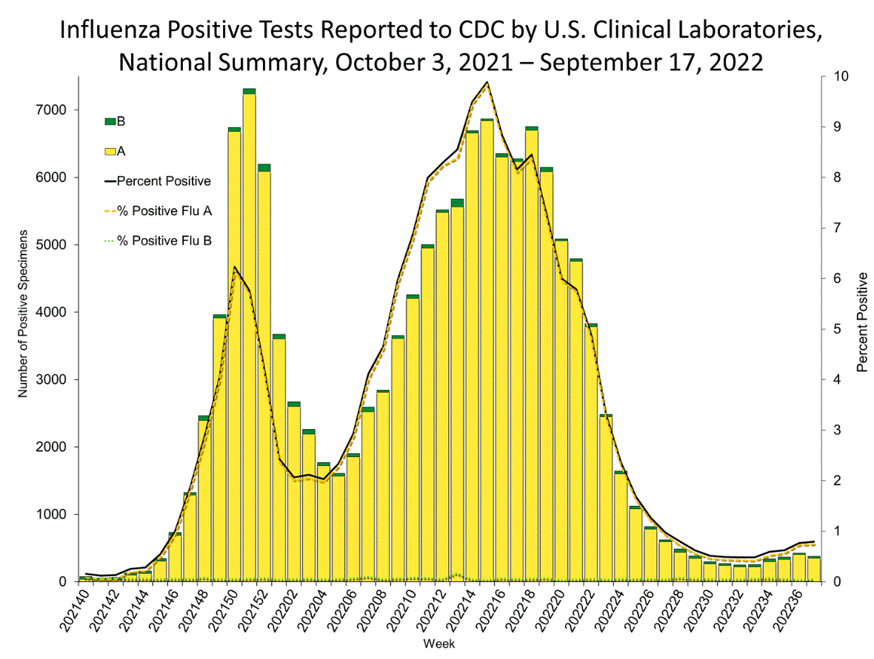
In case you missed it:
COVID
- In Tuesday’s Recommendation for Industry, we discussed the return of norovirus and its spread through insufficient handwashing. Read more here.
- COVID booster adds substantial protection against Omicron hospitalization. Three doses of an mRNA COVID-19 vaccine during a time of Omicron variant predominance were tied to a 59% lower odds of hospitalization than two doses, although protection waned over time, finds a US case-control study published late last week in JAMA. Compared to people who only had their initial vaccinations, people with boosters were a lot less likely to have severe COVID for 4-5 months after the booster shot. The authors said that even if the added protection of a third dose wanes over time, the overall risk of hospitalization among vaccinated patients is still low.
- European countries see early signs of autumn COVID-19 rise. In Britain, Susan Hopkins, MBBCh, chief medical officer at the Health Security Agency, in a statement yesterday said COVID-19 rates are still low, but data from the past 7 days shows a rise in hospitalizations and a rise in positive tests reported from the community. In the United States, the Omicron subvariant proportions continue to shift, with BA.5 decreasing slightly again, from 84.6% to 83.1% over the past week, the Centers for Disease Control and Prevention (CDC) said today in its weekly update. Proportions of two subvariants are growing, though their numbers are still small. Levels of BA.2.75 increased from 1.0% to 1.4%, and BF.7 increased from 1.6% to 2.3%. Nationally, COVID markers are still trending downward, the CDC said today in an overview. The 7-day average for new daily cases is 54,186, down 10.6% compared to the previous week. The weekly average for new hospitalizations for COVID declined 9.9% last week, and weekly deaths dropped 12.2%. Since the first week of September when doses of the new updated booster rolled out, 4.4 million people have received it, the CDC said.
- Collected from HealthMap.org, China reports that COVID is still considered worse than flu because it infects a larger % of the population, it seems to mutate more easily evading immunity, and the death toll is likely going to continue to be higher.
Monkeypox
- Global monkeypox cases drop 22%. Steady drops in new monkeypox cases continue in North America and Europe, resulting in a 22% overall decline in cases reported in the last week. There are 5 more global deaths since the WHO’s previous report on Sep 7, raising the total to 23 (of the deaths, 14 are from African countries). In the past week, 23 nations have reported increases in cases, with Chile reporting the most significant jump. Three countries have reported their first cases, Guam, Bahrain, and Ukraine. The WHO director-general said 105 countries have reported 62,000 confirmed cases of the virus but underscored the direction of falling cases.
Food Safety & Public Health
- New York state health officials said that four deaths at a Manhattan nursing home were confirmed to be linked to an outbreak of Legionnaires’ disease, a serious type of pneumonia caused by bacteria that grows in warm water, while a fifth death remains under investigation. Investigation of the source is underway, with recommendations for water restrictions in place.
- Hundreds of thousands of people displaced by the floods in Pakistan are living in the open and as flood waters spread over hundreds of kilometers start to recede, which officials say may take two to six months, stagnant waters have led to diseases like malaria, dengue fever, skin and eye infections and acute diarrhea. Over 2.7 million people have been treated for water-borne diseases at makeshift or mobile hospitals set up in flood-hit regions since July 1.
- The largest documented outbreak of norovirus illness in the Grand Canyon backcountry resulted in more than 200 confirmed cases, and likely a lot more that went uncounted. Norovirus outbreaks have popped up in the Grand Canyon previously since the virus can live in the river’s water, and then easily spread among groups who all use the same toilets and eat communally. The virus can survive in beach sand, where rafters set up camps, allowing it to spread between trips. Hand sanitizer, a favorite among backpackers or rafters looking to bring less gear, doesn’t kill norovirus, according to the CDC. As the number of tourists visiting the national park has grown, outbreaks have become more frequent over the years.
- Norovirus returns to pre-pandemic levels, CDC data show. Data from NoroSTAT — a network of 12 states that report norovirus outbreaks to the CDC — showed there were nearly triple the outbreaks from August 2021 through July 2022 compared with the same time period in 2020-2021. Norovirus transmission can be prevented by thorough handwashing, avoiding food preparation for at least 2 days after symptoms end, and properly cleaning contaminated areas, according to the CDC.

- Uganda Ebola outbreak area expands, cases jump to 36, deaths to 23. Uganda’s health ministry today reported a steady increase in Ebola Sudan cases in the past few days, bringing the total to 36 of which 23 (64%) have proved fatal. Last week, the World Health Organization (WHO) said the outbreak location poses a risk of further spread, because it is on a busy road that leads to the Democratic Republic of the Congo and because the area contains gold mines that attract people from within and outside of Uganda. The WHO said the risk to Uganda is high, since there is no vaccine and that the outbreak may have started 3 weeks before the first case was detected, raising the possibility of several undetected transmission chains. Doctors Without Borders (MSF) also said it is putting together a team of health workers, epidemiologists, and logisticians who have experience with hemorrhagic fevers to start work this week.
- Cheese, fish, dried fruit among foods subject to new import enforcement: An update from the FDA can be found here, with detailed information on the import alerts that have been modified.
- Nearly 44 tons of meat products recalled after Listeria found in processing facility. Behrmann Meat and Processing Inc., of Albers, IL, is recalling 87,382 pounds of various ready-to-eat (RTE) meat products that may be adulterated with Listeria monocytogenes, the U.S. Department of Agriculture’s Food Safety and Inspection Service (FSIS) announced. The problem was discovered through product and environmental testing performed by FSIS and the establishment. These items were shipped to retail locations and wholesale distributors in Illinois, Kentucky, and Missouri. The various RTE meat items were produced from July 7, 2022, to Sept. 9, 2022. The list of affected products can be found here.
- U.S. slips down rankings in food security index. The study from Economist Impact put Finland at the top, followed by Ireland, Norway, and France. Canada was seventh and the United Kingdom was ninth. The United States dropped to 13th from ninth in the previous edition. Based solely on the quality and safety metric, Canada was first and the United States was third. The UK was 29th. GFSI data for the United States suggests that it needs to improve policy commitments around food security and access by establishing a food security agency and implementing a related strategy.






